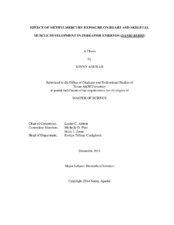| dc.description.abstract | Mercury (Hg) in its elemental form is not effectively absorbed into the body until a methyl group is bound to an atom of Hg, creating methylmercury. Methylmercury (MeHg) is then readily absorbed from the digestive tract, and has demonstrated neurotoxic effects in both the developing and mature central nervous system (CNS). Previous studies have shown that exposure to high concentrations of MeHg results in both high morbidity and mortality rates demonstrated by cases of exposure I n the Faroe Islands, Japan and Iraq. Common symptoms exhibited after high exposure to MeHg included sensory disturbances in adults, while children demonstrate anatomical abnormalities and cognitive defects. Recent zebrafish studies have demonstrated decreased hatching rate, movement, and length along with abnormal/disorganized skeletal muscle, and heart related problems. To better understand the neurotoxic mechanisms of MeHg on zebrafish development, we investigated overall embryo growth, various aspects of heart development, and neuromuscular junction (NMJ) development.
Using zebrafish embryos (ZFEs) as an animal model this study revealed that MeHg exposure for 24 hours had an effect on ZFEs , resulting in decreased heart rate, body length, elicited movement and spontaneous movement, including the number of times ZFEs spontaneously moved during the assessment time of one minute. MeHg exposure in ZFEs had no significant effect on mortality rate, hatching rate, yolk sac area, heart volume ventricle thickness, and pericardial cavity volume, as well as clustering of acetylcholine receptors (AChRs) and presynaptic vesicle aggregates at the NMJ.
This study has confirmed previous reports in the literature that MeHg exposure has adverse effects on the general development of ZFEs. MeHg exposure also had adverse effects on heart development as well as skeletal muscle development, which adversely effected movement. Exposure to 24 hours of low concentrations of MeHg is likely to result in functional deficits that are not reflected in obvious morphologic deficits. | en |


